IMD11112 Design and Dialogue Report: Campus Garden Application
VerifiedAdded on 2023/04/21
|27
|5222
|178
Report
AI Summary
This report details the design and development of an interactive mobile application for the Napier Lion’s Gate project at the Merchiston campus. The application aims to enhance visitor experience within the campus garden by integrating augmented reality (AR), the Internet of Things (IoT), and user experience (UX) design principles. The report explores various design approaches, including conceptual design, design language, and the use of icons and typography. It also includes online research on AR and VR technologies, along with the application's architecture, which is built on the Vufuria SDK. Furthermore, the report covers the AR experience, the functionality of IoT, and the application's features, such as an interactive campus map, visitor scheduling, and plant information through camera functionalities and proximity sensors. Evaluation and testing methods, including participant-based evaluation and usability testing, are also discussed. The report concludes with potential future enhancements and provides references for further study.
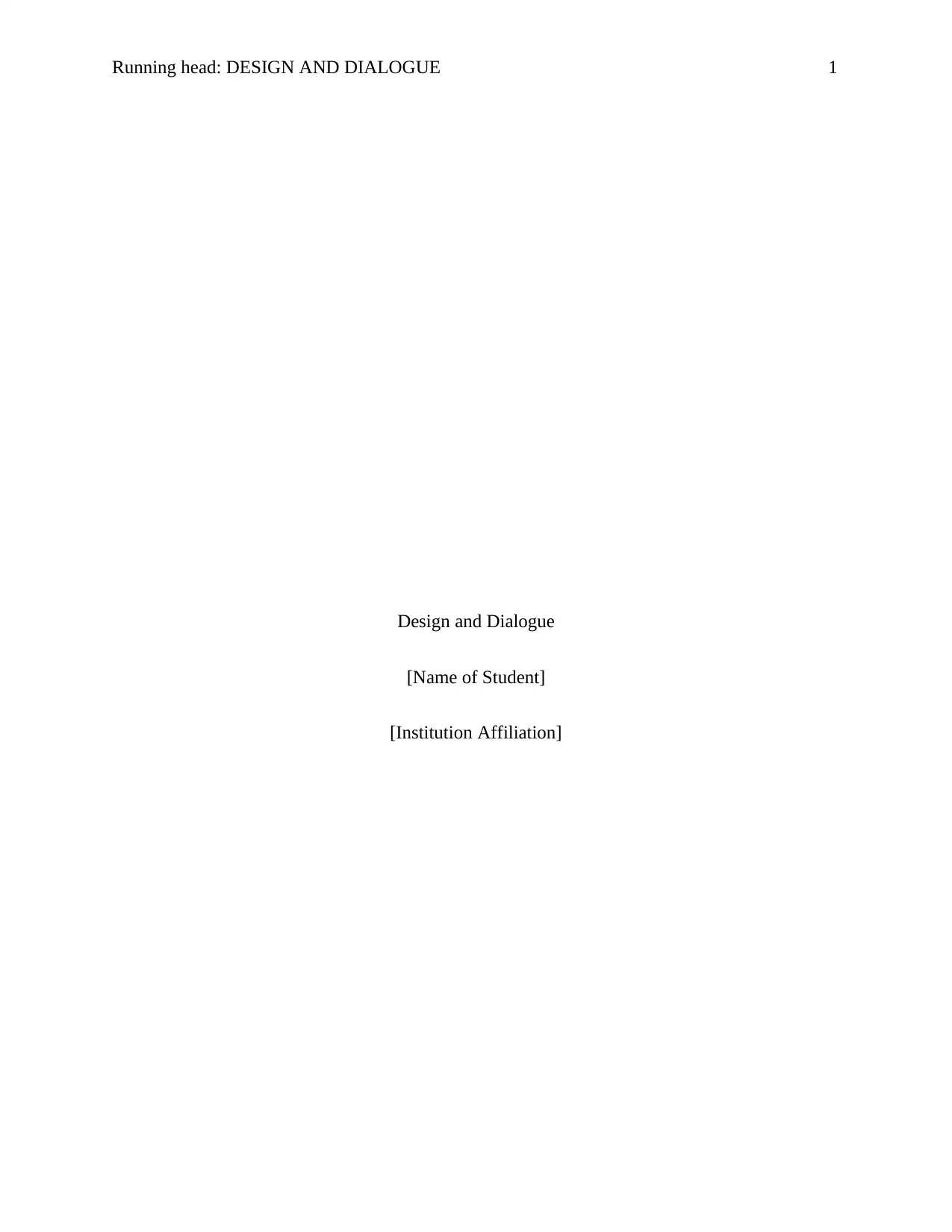
Running head: DESIGN AND DIALOGUE 1
Design and Dialogue
[Name of Student]
[Institution Affiliation]
Design and Dialogue
[Name of Student]
[Institution Affiliation]
Paraphrase This Document
Need a fresh take? Get an instant paraphrase of this document with our AI Paraphraser
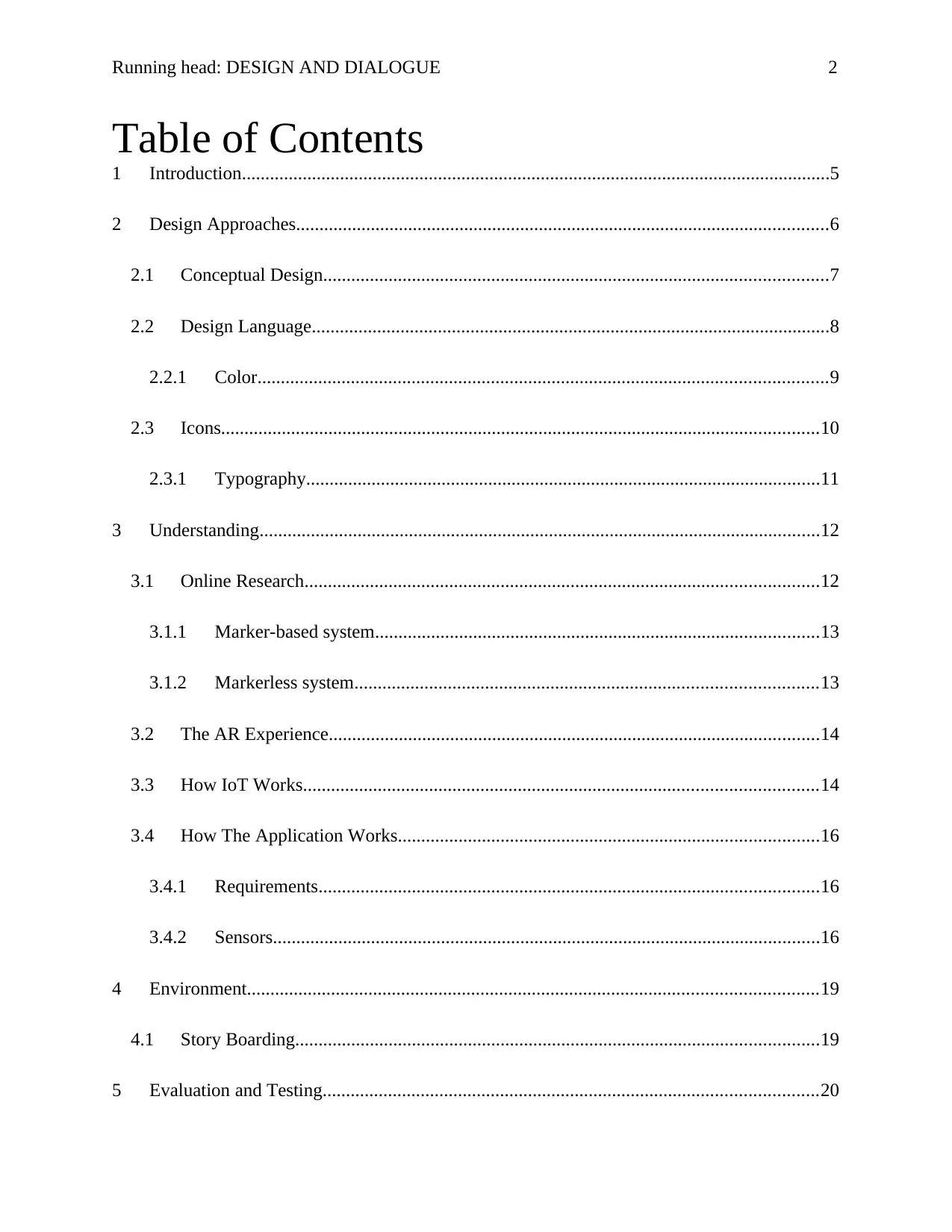
Running head: DESIGN AND DIALOGUE 2
Table of Contents
1 Introduction..............................................................................................................................5
2 Design Approaches..................................................................................................................6
2.1 Conceptual Design............................................................................................................7
2.2 Design Language...............................................................................................................8
2.2.1 Color..........................................................................................................................9
2.3 Icons................................................................................................................................10
2.3.1 Typography..............................................................................................................11
3 Understanding........................................................................................................................12
3.1 Online Research..............................................................................................................12
3.1.1 Marker-based system...............................................................................................13
3.1.2 Markerless system...................................................................................................13
3.2 The AR Experience.........................................................................................................14
3.3 How IoT Works..............................................................................................................14
3.4 How The Application Works..........................................................................................16
3.4.1 Requirements...........................................................................................................16
3.4.2 Sensors.....................................................................................................................16
4 Environment..........................................................................................................................19
4.1 Story Boarding................................................................................................................19
5 Evaluation and Testing..........................................................................................................20
Table of Contents
1 Introduction..............................................................................................................................5
2 Design Approaches..................................................................................................................6
2.1 Conceptual Design............................................................................................................7
2.2 Design Language...............................................................................................................8
2.2.1 Color..........................................................................................................................9
2.3 Icons................................................................................................................................10
2.3.1 Typography..............................................................................................................11
3 Understanding........................................................................................................................12
3.1 Online Research..............................................................................................................12
3.1.1 Marker-based system...............................................................................................13
3.1.2 Markerless system...................................................................................................13
3.2 The AR Experience.........................................................................................................14
3.3 How IoT Works..............................................................................................................14
3.4 How The Application Works..........................................................................................16
3.4.1 Requirements...........................................................................................................16
3.4.2 Sensors.....................................................................................................................16
4 Environment..........................................................................................................................19
4.1 Story Boarding................................................................................................................19
5 Evaluation and Testing..........................................................................................................20
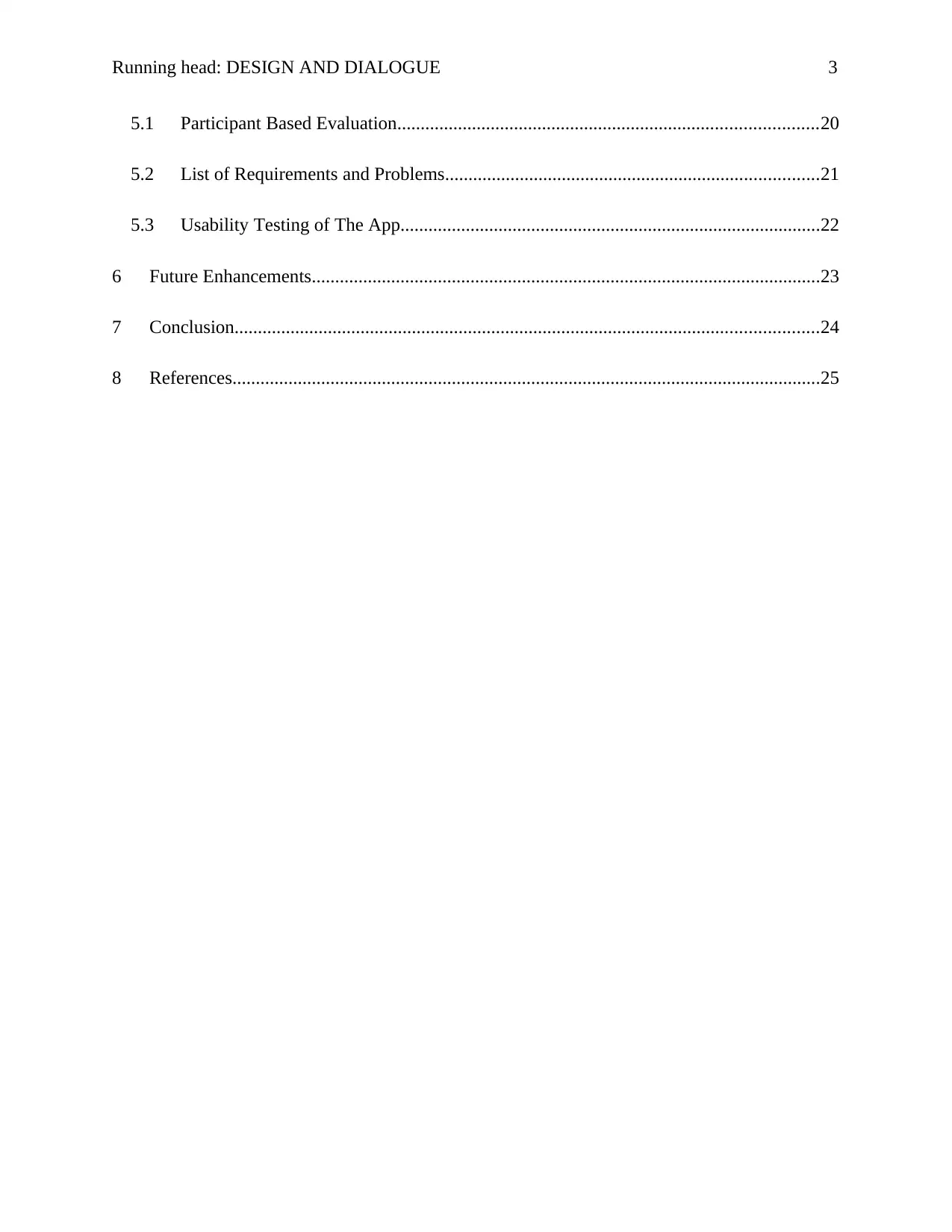
Running head: DESIGN AND DIALOGUE 3
5.1 Participant Based Evaluation..........................................................................................20
5.2 List of Requirements and Problems................................................................................21
5.3 Usability Testing of The App..........................................................................................22
6 Future Enhancements.............................................................................................................23
7 Conclusion.............................................................................................................................24
8 References..............................................................................................................................25
5.1 Participant Based Evaluation..........................................................................................20
5.2 List of Requirements and Problems................................................................................21
5.3 Usability Testing of The App..........................................................................................22
6 Future Enhancements.............................................................................................................23
7 Conclusion.............................................................................................................................24
8 References..............................................................................................................................25
⊘ This is a preview!⊘
Do you want full access?
Subscribe today to unlock all pages.

Trusted by 1+ million students worldwide
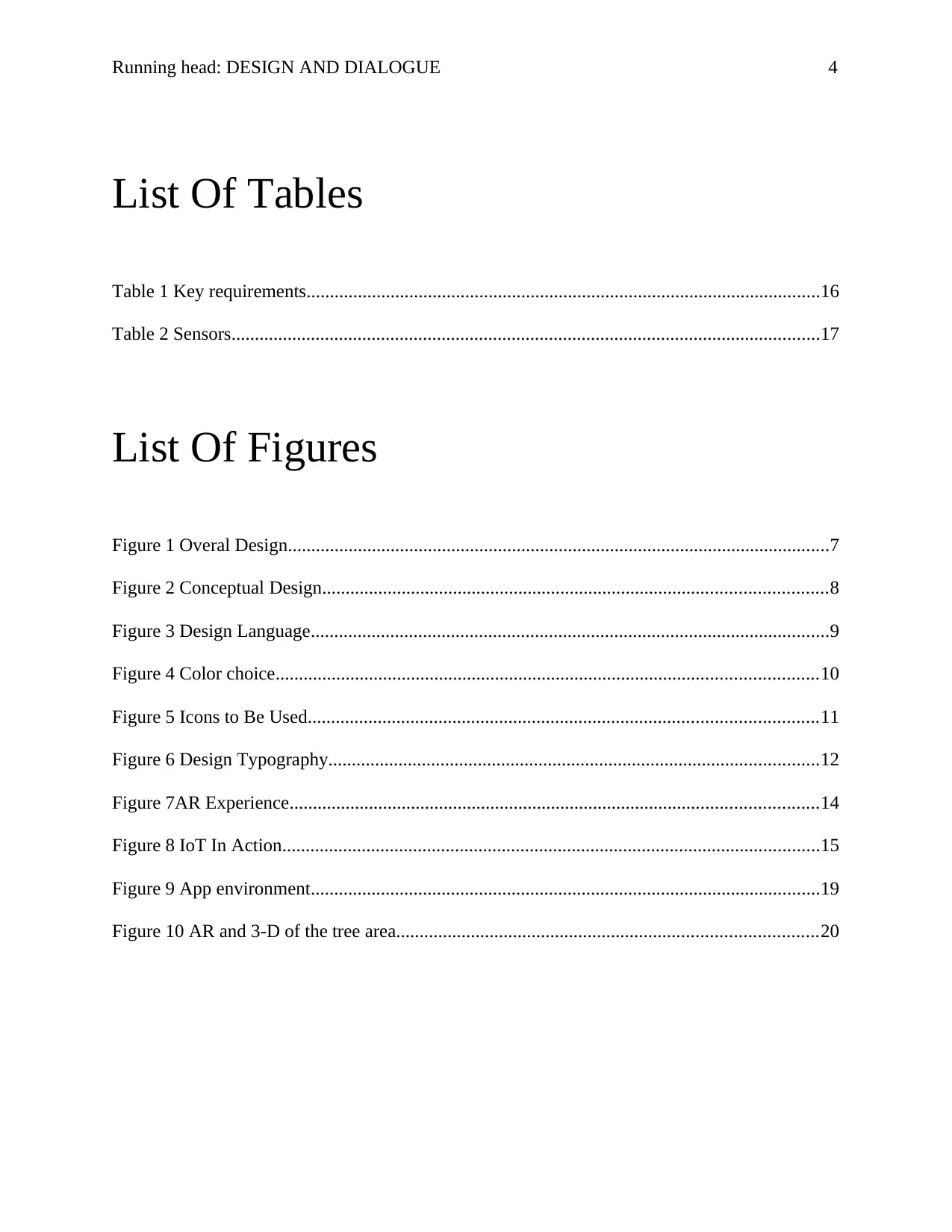
Running head: DESIGN AND DIALOGUE 4
List Of Tables
Table 1 Key requirements..............................................................................................................16
Table 2 Sensors..............................................................................................................................17
List Of Figures
Figure 1 Overal Design....................................................................................................................7
Figure 2 Conceptual Design............................................................................................................8
Figure 3 Design Language...............................................................................................................9
Figure 4 Color choice....................................................................................................................10
Figure 5 Icons to Be Used.............................................................................................................11
Figure 6 Design Typography.........................................................................................................12
Figure 7AR Experience.................................................................................................................14
Figure 8 IoT In Action...................................................................................................................15
Figure 9 App environment.............................................................................................................19
Figure 10 AR and 3-D of the tree area..........................................................................................20
List Of Tables
Table 1 Key requirements..............................................................................................................16
Table 2 Sensors..............................................................................................................................17
List Of Figures
Figure 1 Overal Design....................................................................................................................7
Figure 2 Conceptual Design............................................................................................................8
Figure 3 Design Language...............................................................................................................9
Figure 4 Color choice....................................................................................................................10
Figure 5 Icons to Be Used.............................................................................................................11
Figure 6 Design Typography.........................................................................................................12
Figure 7AR Experience.................................................................................................................14
Figure 8 IoT In Action...................................................................................................................15
Figure 9 App environment.............................................................................................................19
Figure 10 AR and 3-D of the tree area..........................................................................................20
Paraphrase This Document
Need a fresh take? Get an instant paraphrase of this document with our AI Paraphraser
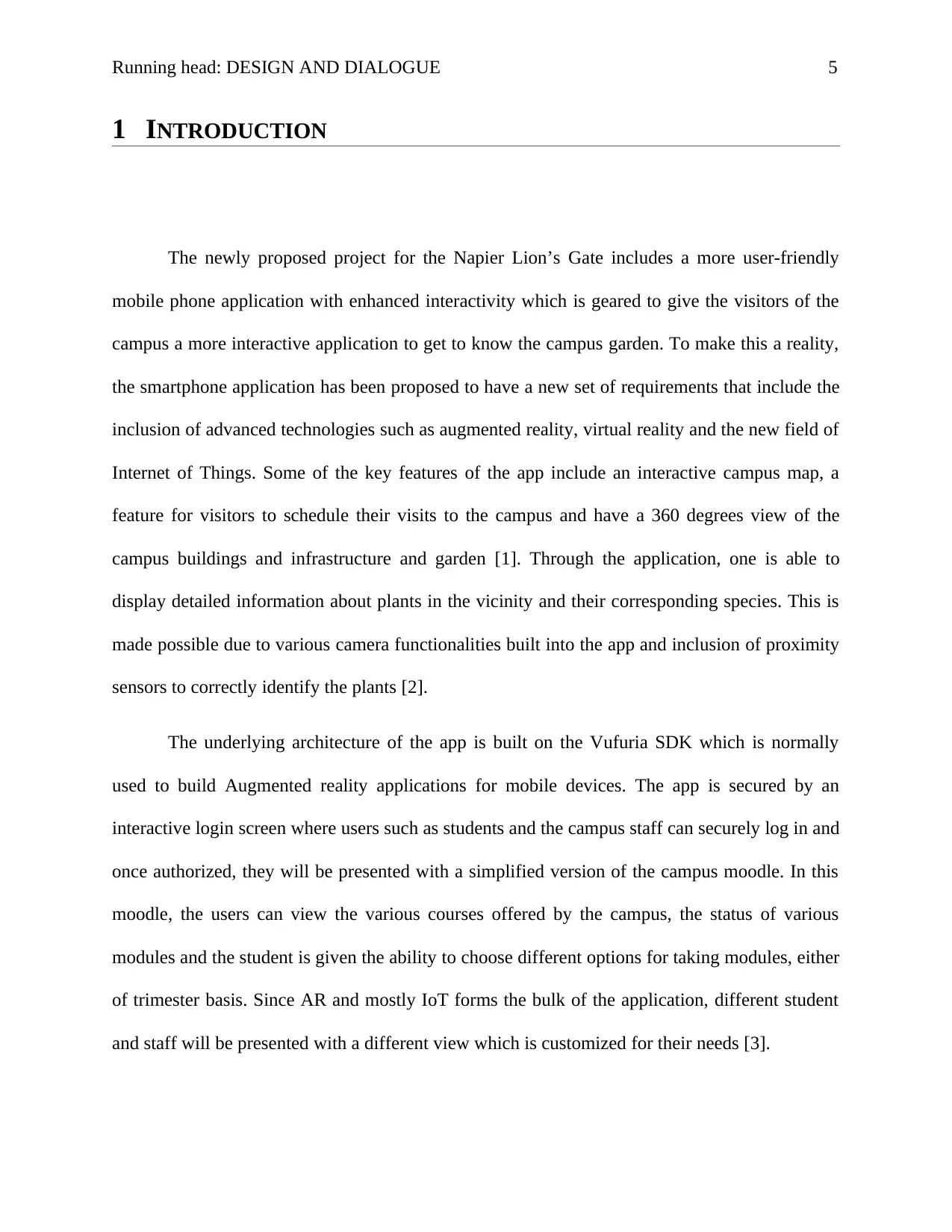
Running head: DESIGN AND DIALOGUE 5
1 INTRODUCTION
The newly proposed project for the Napier Lion’s Gate includes a more user-friendly
mobile phone application with enhanced interactivity which is geared to give the visitors of the
campus a more interactive application to get to know the campus garden. To make this a reality,
the smartphone application has been proposed to have a new set of requirements that include the
inclusion of advanced technologies such as augmented reality, virtual reality and the new field of
Internet of Things. Some of the key features of the app include an interactive campus map, a
feature for visitors to schedule their visits to the campus and have a 360 degrees view of the
campus buildings and infrastructure and garden [1]. Through the application, one is able to
display detailed information about plants in the vicinity and their corresponding species. This is
made possible due to various camera functionalities built into the app and inclusion of proximity
sensors to correctly identify the plants [2].
The underlying architecture of the app is built on the Vufuria SDK which is normally
used to build Augmented reality applications for mobile devices. The app is secured by an
interactive login screen where users such as students and the campus staff can securely log in and
once authorized, they will be presented with a simplified version of the campus moodle. In this
moodle, the users can view the various courses offered by the campus, the status of various
modules and the student is given the ability to choose different options for taking modules, either
of trimester basis. Since AR and mostly IoT forms the bulk of the application, different student
and staff will be presented with a different view which is customized for their needs [3].
1 INTRODUCTION
The newly proposed project for the Napier Lion’s Gate includes a more user-friendly
mobile phone application with enhanced interactivity which is geared to give the visitors of the
campus a more interactive application to get to know the campus garden. To make this a reality,
the smartphone application has been proposed to have a new set of requirements that include the
inclusion of advanced technologies such as augmented reality, virtual reality and the new field of
Internet of Things. Some of the key features of the app include an interactive campus map, a
feature for visitors to schedule their visits to the campus and have a 360 degrees view of the
campus buildings and infrastructure and garden [1]. Through the application, one is able to
display detailed information about plants in the vicinity and their corresponding species. This is
made possible due to various camera functionalities built into the app and inclusion of proximity
sensors to correctly identify the plants [2].
The underlying architecture of the app is built on the Vufuria SDK which is normally
used to build Augmented reality applications for mobile devices. The app is secured by an
interactive login screen where users such as students and the campus staff can securely log in and
once authorized, they will be presented with a simplified version of the campus moodle. In this
moodle, the users can view the various courses offered by the campus, the status of various
modules and the student is given the ability to choose different options for taking modules, either
of trimester basis. Since AR and mostly IoT forms the bulk of the application, different student
and staff will be presented with a different view which is customized for their needs [3].
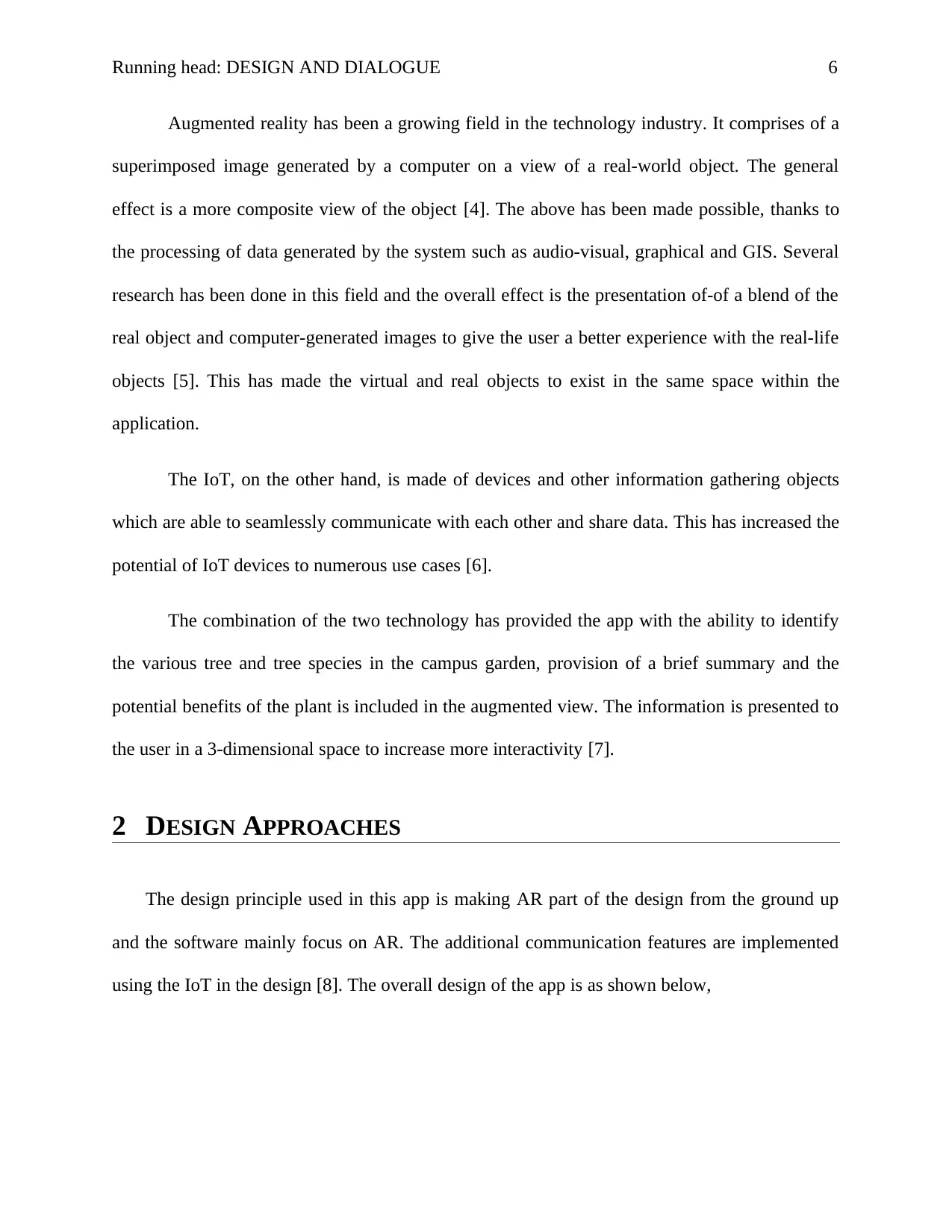
Running head: DESIGN AND DIALOGUE 6
Augmented reality has been a growing field in the technology industry. It comprises of a
superimposed image generated by a computer on a view of a real-world object. The general
effect is a more composite view of the object [4]. The above has been made possible, thanks to
the processing of data generated by the system such as audio-visual, graphical and GIS. Several
research has been done in this field and the overall effect is the presentation of-of a blend of the
real object and computer-generated images to give the user a better experience with the real-life
objects [5]. This has made the virtual and real objects to exist in the same space within the
application.
The IoT, on the other hand, is made of devices and other information gathering objects
which are able to seamlessly communicate with each other and share data. This has increased the
potential of IoT devices to numerous use cases [6].
The combination of the two technology has provided the app with the ability to identify
the various tree and tree species in the campus garden, provision of a brief summary and the
potential benefits of the plant is included in the augmented view. The information is presented to
the user in a 3-dimensional space to increase more interactivity [7].
2 DESIGN APPROACHES
The design principle used in this app is making AR part of the design from the ground up
and the software mainly focus on AR. The additional communication features are implemented
using the IoT in the design [8]. The overall design of the app is as shown below,
Augmented reality has been a growing field in the technology industry. It comprises of a
superimposed image generated by a computer on a view of a real-world object. The general
effect is a more composite view of the object [4]. The above has been made possible, thanks to
the processing of data generated by the system such as audio-visual, graphical and GIS. Several
research has been done in this field and the overall effect is the presentation of-of a blend of the
real object and computer-generated images to give the user a better experience with the real-life
objects [5]. This has made the virtual and real objects to exist in the same space within the
application.
The IoT, on the other hand, is made of devices and other information gathering objects
which are able to seamlessly communicate with each other and share data. This has increased the
potential of IoT devices to numerous use cases [6].
The combination of the two technology has provided the app with the ability to identify
the various tree and tree species in the campus garden, provision of a brief summary and the
potential benefits of the plant is included in the augmented view. The information is presented to
the user in a 3-dimensional space to increase more interactivity [7].
2 DESIGN APPROACHES
The design principle used in this app is making AR part of the design from the ground up
and the software mainly focus on AR. The additional communication features are implemented
using the IoT in the design [8]. The overall design of the app is as shown below,
⊘ This is a preview!⊘
Do you want full access?
Subscribe today to unlock all pages.

Trusted by 1+ million students worldwide
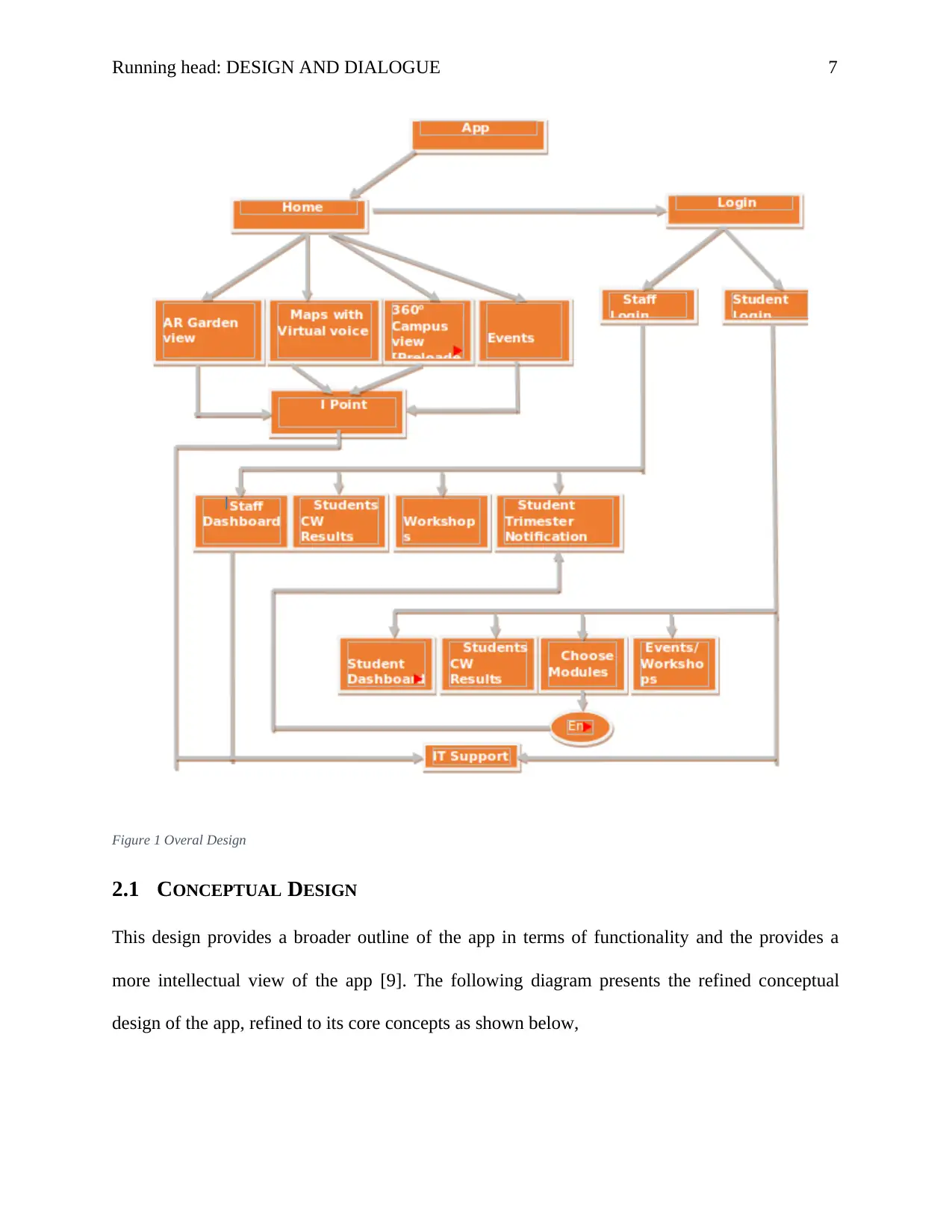
Running head: DESIGN AND DIALOGUE 7
Figure 1 Overal Design
2.1 CONCEPTUAL DESIGN
This design provides a broader outline of the app in terms of functionality and the provides a
more intellectual view of the app [9]. The following diagram presents the refined conceptual
design of the app, refined to its core concepts as shown below,
Figure 1 Overal Design
2.1 CONCEPTUAL DESIGN
This design provides a broader outline of the app in terms of functionality and the provides a
more intellectual view of the app [9]. The following diagram presents the refined conceptual
design of the app, refined to its core concepts as shown below,
Paraphrase This Document
Need a fresh take? Get an instant paraphrase of this document with our AI Paraphraser
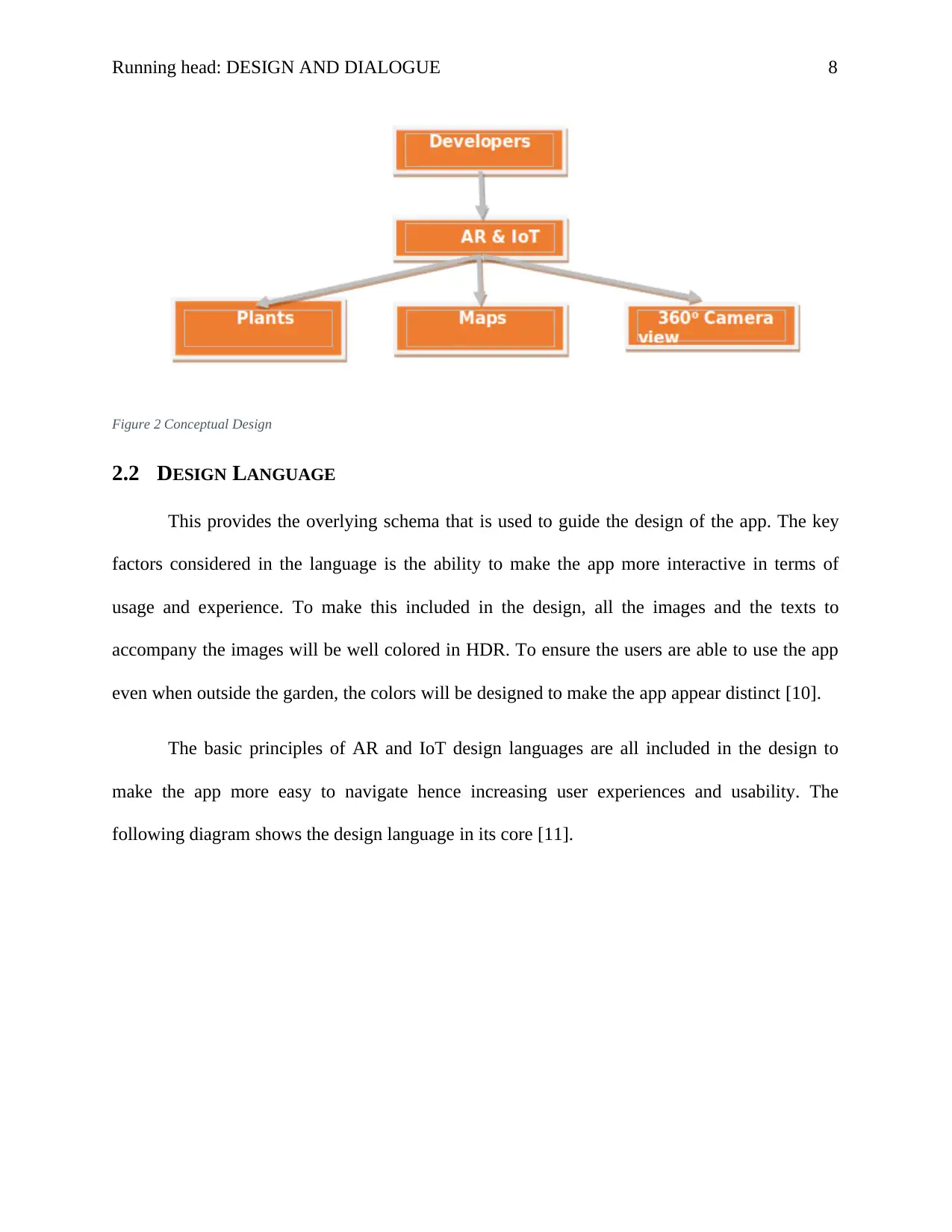
Running head: DESIGN AND DIALOGUE 8
Figure 2 Conceptual Design
2.2 DESIGN LANGUAGE
This provides the overlying schema that is used to guide the design of the app. The key
factors considered in the language is the ability to make the app more interactive in terms of
usage and experience. To make this included in the design, all the images and the texts to
accompany the images will be well colored in HDR. To ensure the users are able to use the app
even when outside the garden, the colors will be designed to make the app appear distinct [10].
The basic principles of AR and IoT design languages are all included in the design to
make the app more easy to navigate hence increasing user experiences and usability. The
following diagram shows the design language in its core [11].
Figure 2 Conceptual Design
2.2 DESIGN LANGUAGE
This provides the overlying schema that is used to guide the design of the app. The key
factors considered in the language is the ability to make the app more interactive in terms of
usage and experience. To make this included in the design, all the images and the texts to
accompany the images will be well colored in HDR. To ensure the users are able to use the app
even when outside the garden, the colors will be designed to make the app appear distinct [10].
The basic principles of AR and IoT design languages are all included in the design to
make the app more easy to navigate hence increasing user experiences and usability. The
following diagram shows the design language in its core [11].
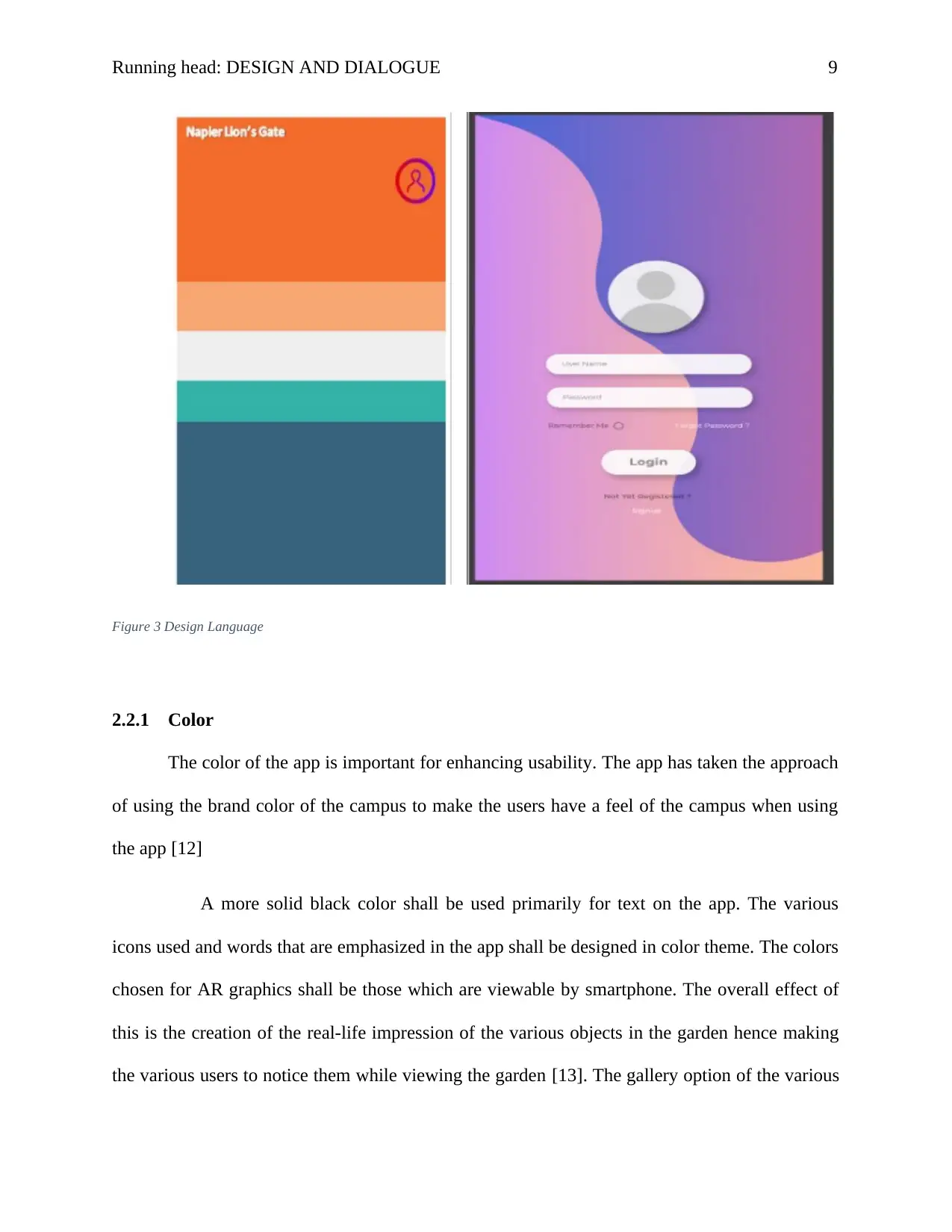
Running head: DESIGN AND DIALOGUE 9
Figure 3 Design Language
2.2.1 Color
The color of the app is important for enhancing usability. The app has taken the approach
of using the brand color of the campus to make the users have a feel of the campus when using
the app [12]
A more solid black color shall be used primarily for text on the app. The various
icons used and words that are emphasized in the app shall be designed in color theme. The colors
chosen for AR graphics shall be those which are viewable by smartphone. The overall effect of
this is the creation of the real-life impression of the various objects in the garden hence making
the various users to notice them while viewing the garden [13]. The gallery option of the various
Figure 3 Design Language
2.2.1 Color
The color of the app is important for enhancing usability. The app has taken the approach
of using the brand color of the campus to make the users have a feel of the campus when using
the app [12]
A more solid black color shall be used primarily for text on the app. The various
icons used and words that are emphasized in the app shall be designed in color theme. The colors
chosen for AR graphics shall be those which are viewable by smartphone. The overall effect of
this is the creation of the real-life impression of the various objects in the garden hence making
the various users to notice them while viewing the garden [13]. The gallery option of the various
⊘ This is a preview!⊘
Do you want full access?
Subscribe today to unlock all pages.

Trusted by 1+ million students worldwide
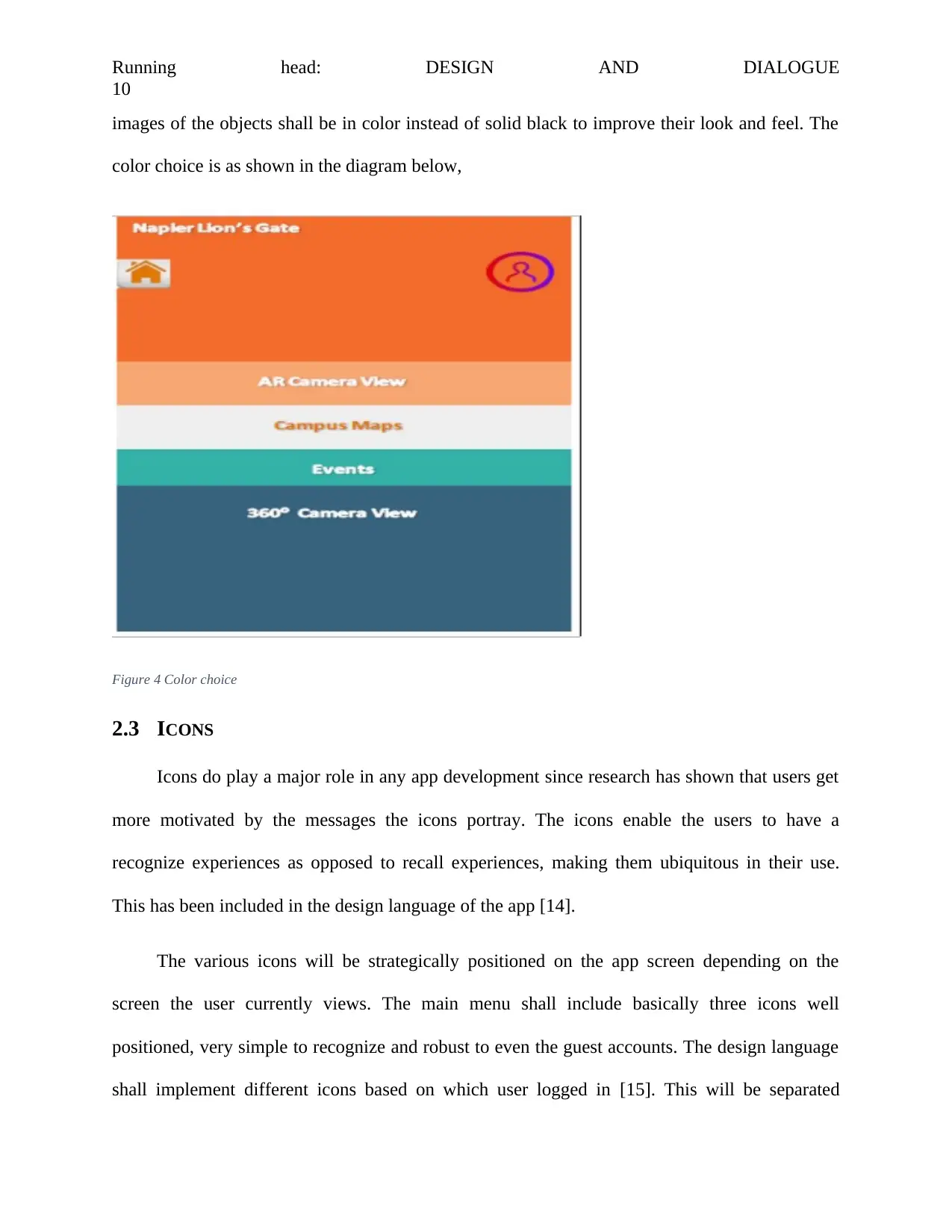
Running head: DESIGN AND DIALOGUE
10
images of the objects shall be in color instead of solid black to improve their look and feel. The
color choice is as shown in the diagram below,
Figure 4 Color choice
2.3 ICONS
Icons do play a major role in any app development since research has shown that users get
more motivated by the messages the icons portray. The icons enable the users to have a
recognize experiences as opposed to recall experiences, making them ubiquitous in their use.
This has been included in the design language of the app [14].
The various icons will be strategically positioned on the app screen depending on the
screen the user currently views. The main menu shall include basically three icons well
positioned, very simple to recognize and robust to even the guest accounts. The design language
shall implement different icons based on which user logged in [15]. This will be separated
10
images of the objects shall be in color instead of solid black to improve their look and feel. The
color choice is as shown in the diagram below,
Figure 4 Color choice
2.3 ICONS
Icons do play a major role in any app development since research has shown that users get
more motivated by the messages the icons portray. The icons enable the users to have a
recognize experiences as opposed to recall experiences, making them ubiquitous in their use.
This has been included in the design language of the app [14].
The various icons will be strategically positioned on the app screen depending on the
screen the user currently views. The main menu shall include basically three icons well
positioned, very simple to recognize and robust to even the guest accounts. The design language
shall implement different icons based on which user logged in [15]. This will be separated
Paraphrase This Document
Need a fresh take? Get an instant paraphrase of this document with our AI Paraphraser
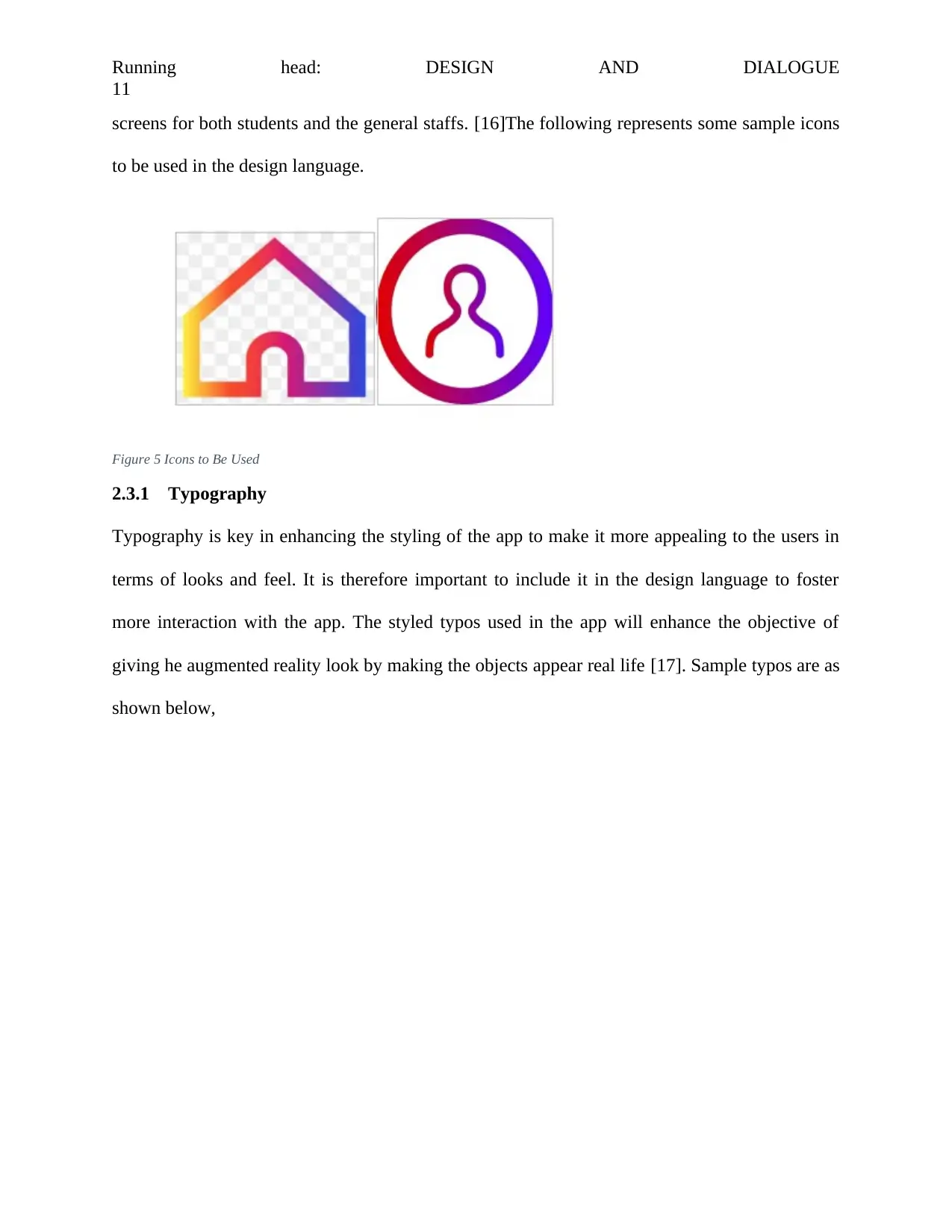
Running head: DESIGN AND DIALOGUE
11
screens for both students and the general staffs. [16]The following represents some sample icons
to be used in the design language.
Figure 5 Icons to Be Used
2.3.1 Typography
Typography is key in enhancing the styling of the app to make it more appealing to the users in
terms of looks and feel. It is therefore important to include it in the design language to foster
more interaction with the app. The styled typos used in the app will enhance the objective of
giving he augmented reality look by making the objects appear real life [17]. Sample typos are as
shown below,
11
screens for both students and the general staffs. [16]The following represents some sample icons
to be used in the design language.
Figure 5 Icons to Be Used
2.3.1 Typography
Typography is key in enhancing the styling of the app to make it more appealing to the users in
terms of looks and feel. It is therefore important to include it in the design language to foster
more interaction with the app. The styled typos used in the app will enhance the objective of
giving he augmented reality look by making the objects appear real life [17]. Sample typos are as
shown below,
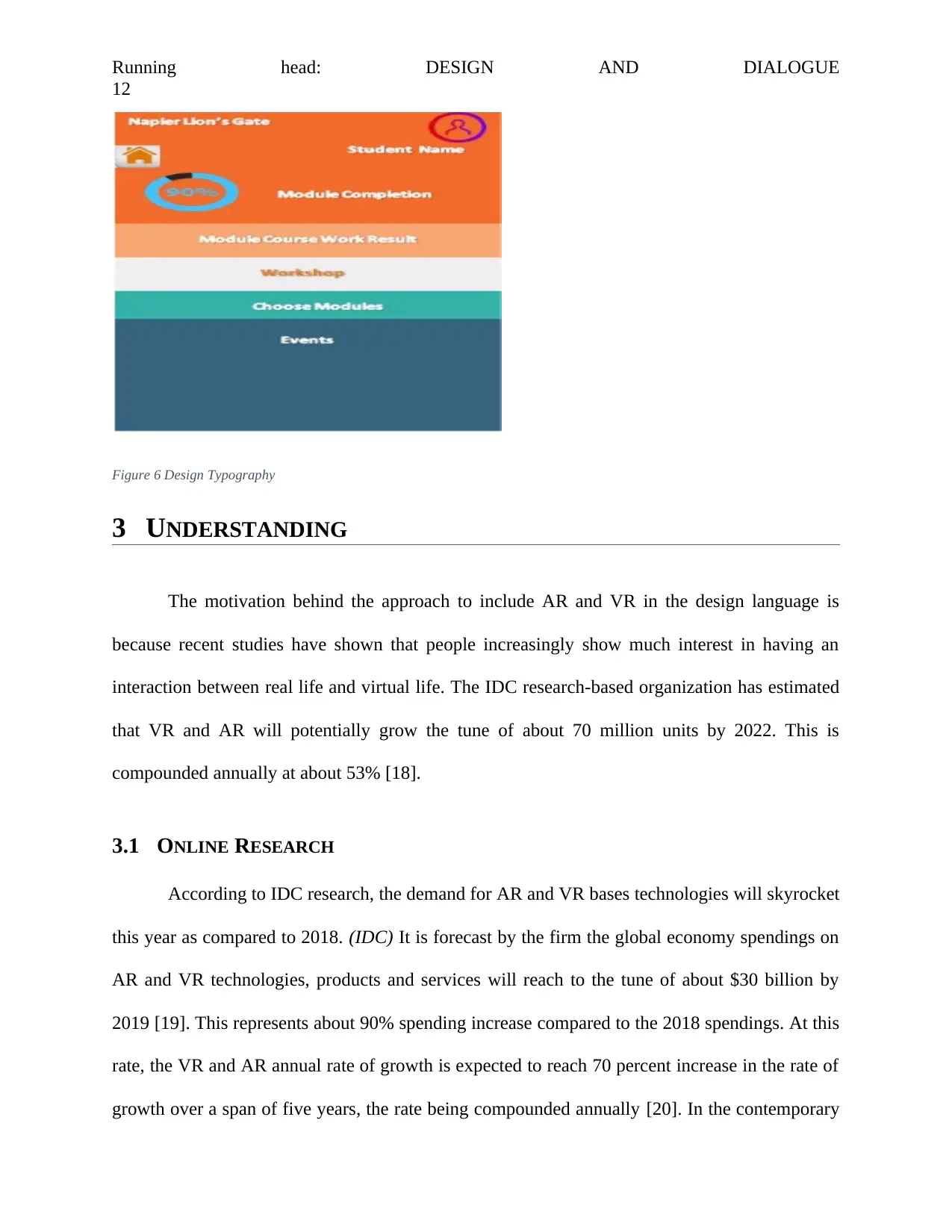
Running head: DESIGN AND DIALOGUE
12
Figure 6 Design Typography
3 UNDERSTANDING
The motivation behind the approach to include AR and VR in the design language is
because recent studies have shown that people increasingly show much interest in having an
interaction between real life and virtual life. The IDC research-based organization has estimated
that VR and AR will potentially grow the tune of about 70 million units by 2022. This is
compounded annually at about 53% [18].
3.1 ONLINE RESEARCH
According to IDC research, the demand for AR and VR bases technologies will skyrocket
this year as compared to 2018. (IDC) It is forecast by the firm the global economy spendings on
AR and VR technologies, products and services will reach to the tune of about $30 billion by
2019 [19]. This represents about 90% spending increase compared to the 2018 spendings. At this
rate, the VR and AR annual rate of growth is expected to reach 70 percent increase in the rate of
growth over a span of five years, the rate being compounded annually [20]. In the contemporary
12
Figure 6 Design Typography
3 UNDERSTANDING
The motivation behind the approach to include AR and VR in the design language is
because recent studies have shown that people increasingly show much interest in having an
interaction between real life and virtual life. The IDC research-based organization has estimated
that VR and AR will potentially grow the tune of about 70 million units by 2022. This is
compounded annually at about 53% [18].
3.1 ONLINE RESEARCH
According to IDC research, the demand for AR and VR bases technologies will skyrocket
this year as compared to 2018. (IDC) It is forecast by the firm the global economy spendings on
AR and VR technologies, products and services will reach to the tune of about $30 billion by
2019 [19]. This represents about 90% spending increase compared to the 2018 spendings. At this
rate, the VR and AR annual rate of growth is expected to reach 70 percent increase in the rate of
growth over a span of five years, the rate being compounded annually [20]. In the contemporary
⊘ This is a preview!⊘
Do you want full access?
Subscribe today to unlock all pages.

Trusted by 1+ million students worldwide
1 out of 27
Your All-in-One AI-Powered Toolkit for Academic Success.
+13062052269
info@desklib.com
Available 24*7 on WhatsApp / Email
![[object Object]](/_next/static/media/star-bottom.7253800d.svg)
Unlock your academic potential
Copyright © 2020–2025 A2Z Services. All Rights Reserved. Developed and managed by ZUCOL.
